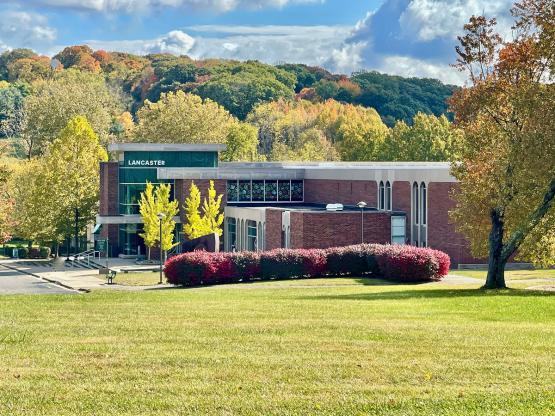

In a time when so many people are looking for job opportunities, employers are still having a hard time filling open positions in advanced manufacturing .
These jobs pay well and are in a growing field. But different obstacles often keep individuals, especially individuals living in rural Ohio, from moving into these positions.
A new grant-funded program, though, will help more people move into advancement manufacturing positions and ideally could help to even create more jobs in the region. The grant project will also provide valuable research into the best ways to help rural high school students get the training they need to move into careers in advanced manufacturing and other growing fields.
Ohio University received more than $2 million in funding from the U.S. Department of Education for this innovative grant program, which involves faculty and staff from four Ohio University colleges and two regional campuses, as well as several community partners in its different initiatives.
The Rural Postsecondary and Economic Development grant
Ohio University received $2,022,519 for its grant project, the Optimizing Navigation for Rural Advanced Manufacturing Pathways. The project is part of the Rural Postsecondary and Economic Development program , which funded 22 grants for projects across the country.
The project states that is goal is to “Increase the number of underserved students in the Southeastern Appalachian region of Ohio who enroll in, and complete, postsecondary educational pathways leading to careers in Advanced Manufacturing and related STEM fields.”
And in order to meet that mission, the program will have three main components:
- Fund career navigators in two targeted regions within the Appalachian Semiconductor Education and Technical (ASCENT) Ecosystem.Those two regions are Fairfield County and Belmont County, where there are two-year and four-year programs in place to help individuals move into these careers at Ohio University Lancaster and the Belmont College in St. Clairsville.
- Provide additional academic advising resources dedicated to ASCENT pathways to supplement and enhance existing structures. The Ohio University ASCENT Ecosystem is funded with a $3 million Intel grant to cultivate the next generation of skilled technical professionals for Ohio’s emerging semiconductor industry and regional advanced manufacturing.
- Leverage the industrial and educational partnerships being made through ASCENTto provide experiential learning opportunities, form career connections and provide a regional employer network.
How will the project help individuals in the region move into these jobs?

“There are a lot of job openings in advanced manufacturing in the region, and employers are having a hard time filling them,” explained Eric Stinaff , professor and chair in the Department of Physics and Astronomy in OHIO’s College of Arts and Sciences, and one of the principal investigators for the grant-funded project.
“Manufacturing is much different today from what it was years ago,” Stinaff said. Employees work in clean environments, and often work with advanced machines and robotics.
“There is a very large need for workers in these areas,” Stinaff said.
Research has shown that many high school students don’t know about the opportunities available in these areas, so part of this grant project will place career navigators in schools in the region. The career navigators will provide information on these programs and will also work with employers and educational programs in the region.
Since Ohio University Lancaster’s Advanced Manufacturing program is a leader in this field along with Belmont College, the grant program will work with schools in Fairfield County and Belmont County to provide information to high school students about the educational programs in their communities.
Many schools in the region already have career navigators who do valuable work, and these new grant-funded positions will be specifically trained with additional information about these opportunities. They will also make connections with employers in the regional to learn more about job opportunities that students may want to receive specialized training for. Those connections could also lead to internships and apprenticeships that allow high school and college students to learn more about these career paths.
In addition, the career navigators and local schools will be provided with assessment tools and aptitude tests that can help students look at career paths that fit their skills and their interests.
“We are trying to test if we have career navigators focused on these areas….what kind of impact will they have,” Stinaff said. Students will be helped no matter what their career interests are, and the hope is that by providing more information and creating more familiarity about these new career options, more students will consider these career paths.
Helping rural high school students now and for years to come
Research has shown that providing information and access to educational programs in new career paths opens doors for high school students, but there are often still obstacles for many rural high school students.
Studies show, for example, that many rural students do not want to move away for job opportunities in other states or regions, explained Associate Professor of Middle Childhood Education Jacqueline Yahn , who is the Eastern Campus coordinator of middle childhood education and one of the principal investigators on the grant project.
“We know in rural education research that family members, parents and caregivers, often have a significant influence on the career pathways that individuals choose,” Yahn said. The family influence also impacts where high school students want to go to college and where they may want to locate after they earn their degrees.
Yahn and her research partners will study the work of the career navigators with the high school students, as well as the impact of the aptitude and skills tests. In addition, they will follow a group of students who are in the tenth grade this year for four years as they go through high school, make choices about higher education and potentially enter any college program.
The research project will also include information from the family members of the students in order to provide a fuller understanding of the students and the choices they face when looking at higher education and careers.
The hope is that the study will provide information on how better to help rural high school students find career opportunities that meet their interests, skills and values not just in advanced manufacturing but in a wide range of fields.
“We saw this as an opportunity to not just fill this gap of knowledge for the ASCENT program, but also a known gap in the empirical literature,” Yahn said. “There is a need to know this well beyond the Appalachian region of Ohio, but these dollars will really help us close to home.”
Collaboration on the project
While the Russ College of Engineering and Technology will provide training and assistance for the career navigators, the Patton College of Education will study the work of the navigators and the assessment tools they use, and Stinaff from the College of Arts and Sciences will be heavily involved, the Voinovich School of Leadership and Public Service will evaluate the grant project as a whole over the next four years.
“They will do the overall assessment examining the effectiveness of the whole project and make sure the programs move forward so that we can achieve the goals we want to achieve,” Stinaff said.
In addition, the project leaders will work closely with Ohio University Lancaster, Belmont College, educational service centers in Fairfield and Belmont counties, and schools in the region.
All of the collaboration is critical to the success of the project, Yahn said.
“It is really special that we can do this,” Yahn said. “I just can’t say enough about it. Everyone on his project is leveraging each other’s skills to benefit kids in this region.”
The other principal investigators on the project are all doing essential work, and they include Allyson Hallman-Thrasher, professor of education in the Patton College of Education and associate dean of the Graduate College, Todd Myers, professor and director of workforce and professional development in the Russ College of Engineering and Technology, and Jacob White, co-director of the Planning, Evaluation, Education and Research (PEER) Applied Research Team in the Voinovich School of Leadership and Public Service.
Increasing job opportunities, boosting the economy

While the grant program focuses on individual high school students and helping them gain information about new career paths that are available to them, it can also have a broader impact on the region as a whole.
Currently, there are advanced manufacturing positions available in the region, and more are expected to open in the coming years through the Intel project and other developments.
“One big goal is to make this area attractive for new industry,” Stinaff said. By increasing the skilled workforce that can move right into these jobs, it will make the region more attractive to companies looking to expand or to locate near Intel or other companies. “We are hoping that Southeast Ohio will look attractive to them.” Stinaff said.
In addition, the project could lead to new programs that could be expanded to more schools in the region and around the country in order to help high school students gain a better understanding of career opportunities that are available to them
“This is really meant to be a model,” Stinaff said.
He and all of the principal investigators are thankful to the Rural Postsecondary and Economic Development program for funding the project and to all of the partners in the region who supported the grant application and will be assisting with the different initiatives over the next four years in order to benefit the region.


